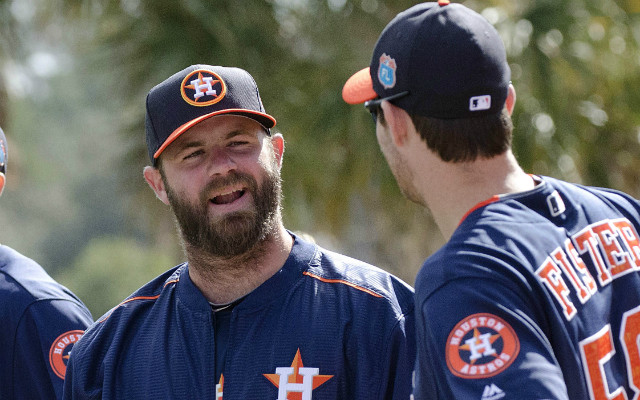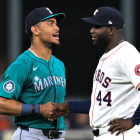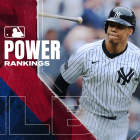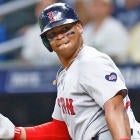A team’s success or lack thereof is never reducible to any one player, or even one segment of the roster. You watch baseball, and you know this. Somewhere on each team, though, is one or more “bellwether” performers upon whom, it may be plausibly stated, the season in question may well hinge. This is baseball, of course, a structurally balanced sport, so it's never any one player or role or even segment of the roster. Sometimes, though, success or failure at the team level can in part cascade from the performance of a less obvious contributor. Or sometimes it’s, yes, someone on the scale of a Mike Trout or a Bryce Harper or a Miguel Cabrera.
That’s the sort of thing we’re talking about right now. We’ve been going division-by-division, and boiling down each team’s essence to the outputs of a player or small group of players. We’ll distill it even further down to one number that the player or players in question need to reach in order for the team in question to make the most of their lot in 2016. What follows, then, are the numbers that will tell the story of the 2016 season for each team.
Up this time around, the vital numbers of the AL West ...
Previous: AL East | NL East | AL Central | NL Central

Houston Astros
The number: AVG/OBP/SLG from first base and DH
The Astros are clearly in good shape heading into 2016 and clearly profile as contenders. However, they’re not poised to get good production from these two bat-first positions. At first base, Houston is set to open the season with Jonathan Singleton as the regular. He has some upside, but thus far he’s hit just .171/.290/.331 in 420 big-league plate appearances. As for the road ahead, the SportsLine projections tab Singleton for a 2016 line of .195/.298/.381. First base prospect A.J. Reed figures to make his way to Houston at some point in 2016, and he’s got some upside. However, early struggles are usually a safe assumption for all but the most premium of prospects.
On the DH front, Evan Gattis may open the season on the DL after undergoing hernia surgery, but he figures to be the primary at the “position.” Gattis has pop from the right side for sure, but he’s long had OBP issues. SportsLine forecasts a .291 on-base percentage for him in 2016. That sounds about right. The other likely DH option, Preston Tucker, doesn’t project much better on the OBP front.
In the end, you’re talking about two positions/roles in which teams need good offensive outputs. The Astros, though, may not get much in the way of on-base skills from first base and DH. That bears watching.


Los Angeles Angels
The number: Starts in left field by Daniel Nava, Craig Gentry, and Todd Cunningham
Mostly because the Angels are right up against the luxury tax threshold, they didn’t have a particularly active winter (the trade for Andrelton Simmons notwithstanding). They of course have Mike Trout, the best player in baseball, and that’s fine start toward a strong roster. However, the Angels have mostly done a poor job of surrounding Trout with contention-grade teammates. In 2016, this is most acutely obvious in left field. In that position -- a non-premium defensive position from which offensive production is expected -- the Angels will try to wring adequacy out of some mix of Daniel Nava, Craig Gentry and Todd Cunningham. Needless to say, this is less than ideal. Per SportsLine, Nava, offensively, projects as the best of the bunch, as he’s tabbed for an OPS of .690 in 2016. By comparison, in 2015 the average major-league left fielder had an OPS of .736, so the Angels, as you would expect, figure to be working from a deficit.
So will this arrangement hold sway, or will GM Billy Eppler be freed up to pursue an upgrade via trade? Since the Angels have the worst farm system in baseball, trading for a useful left fielder would probably entail taking on salary, and that’s where owner Arte Moreno comes in. How many starts in left field this uninspiring trio logs will be telling.

Oakland Athletics
The number: Rotation ERA outside of Sonny Gray
We figure that ace Sonny Gray, if healthy, will again provide top-tier value and be in the discussion for the AL Cy Young in 2016. But what of the remainder? Right now, the A’s 2-5 spots in the rotation figure to run Jesse Hahn, Rich Hill, Chris Bassitt, and Kendall Graveman. Maybe they get some value out of Jarrod Parker. They need that, and they also need Hill’s apparent small-sample-size resurgence to stick. To be sure, the A’s are probably the AL team least likely to contend in 2016, but they’re not as easily dismissed as, say, any of the worst teams in the NL. If Oakland is to be of consequence in 2016, then they’ll need to avoid a steep dropoff from Gray to the rest of the rotation.

Seattle Mariners
The number: Robinson Cano’s OPS+
Cano, the M’s highly-paid second baseman and No. 3 hitter, is entering his age-33 season. It’s quite possible that age-related decline has set in. He entered 2015 with a career OPS+ of 127 and a mark of 142 since 2010. In 2015, though, that figure dropped to 117. That’s still good, especially for a middle infielder, but it’s not vintage Cano. On the other hand, Cano was much better in the second half of 2015 (.331/.387/.540 after the break). There’s nothing magical about first-half/second-half splits, but it’s possible that bodes well moving forward. In the end, the Mariners need Cano to hold steady or improve upon his 2015 overall outputs. The post-All-Star break Cano is what they need, basically.

Texas Rangers
The number: Yu Darvish’s games started
Darvish of course underwent Tommy John surgery in March of last year, and while he’s presently working his way back, he’s not expected to rejoin the Texas rotation until late May or early June. The front of the Texas rotation is obviously in good shape, what with Cole Hamels and Derek Holland in the No. 1 and No. 2 spots, respectively. After that, though, there’s a lack of depth. Until Darvish returns, the Rangers will trot out 36-year-old Colby Lewis in the third spot and then Nick Martinez and Martin Perez in some order. This, of course, is partly a consequence of losing Yovani Gallardo to free agency.
Anyhow, in order to stabilize that back end, the Rangers would love to get 20 regular season starts from Darvish. If he adheres to his current timetable, then he should be able to do that. That, of course, assumes he won’t get hurt again, and he has shown a propensity for injury throughout his career thus far. As well, command is often the last thing to return to a pitcher coming off Tommy John surgery, so that’s a consideration. An effective Darvish means a terrific front three for Texas down the stretch.
Coming Sunday: We'll wrap things up with the NL West.






















